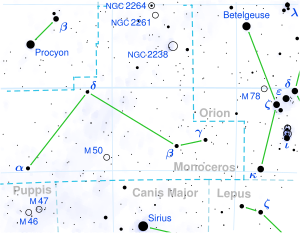
S Monocerotis, also known as 15 Monocerotis, is a massive multiple and variable star system located in the constellation Monoceros. It is the brightest star in the Christmas Tree open cluster in the area catalogued as NGC 2264.
S Monocerotis is found within an open cluster and the Washington Double Star Catalog lists many companion stars.[18] The closest and brightest is S Mon B, magnitude 7.8 and 3 arcseconds away. It is classified as B2 main sequence star with a mass of 7.31 M☉. Designated component C is an 11th-magnitude B8V star.[6] The cluster contains another dozen or so 9th and 10th magnitude stars and many fainter stars.
S Monocerotis A is a spectroscopic binary system with an eccentric orbit of about 112 years.[13] Since 1943, the spectrum of this star has served as the MK standard for O7 by which other stars are classified.[19] It is also an irregular variable star with a range of less than a tenth of a magnitude. The orbital parameters can be used to derive the masses of the two stars, giving 31 M☉ and 11 M☉.[6]
The distance to S Monocerotis and NGC 2264 has been derived in various ways, including dynamical parallax and isochrone fitting. These consistently give estimates of 700 - 900 parsecs, although this is double the likely distance derived from the Hipparcos parallax measurements.[9] Gaia Early Data Release 3 contains parallaxes for the companions components B and C of 1.4 mas and 1.5 mas respectively, consistent with the expected distance to the cluster.
References
- ^ a b c d e Høg, E.; Fabricius, C.; Makarov, V. V.; Urban, S.; Corbin, T.; Wycoff, G.; Bastian, U.; Schwekendiek, P.; Wicenec, A. (2000). "The Tycho-2 catalogue of the 2.5 million brightest stars". Astronomy and Astrophysics. 355: L27. Bibcode:2000A&A...355L..27H. doi:10.1888/0333750888/2862. ISBN 0333750888.
- ^ a b c d Cvetkovc, Zorica; Vince, Istvan; Ninkovic, Slobodan (2008). "Orbit of Binary 15 Monocerotis". arXiv:0804.0698 [astro-ph].
- ^ a b Samus, N. N.; Durlevich, O. V.; et al. (2009). "VizieR Online Data Catalog: General Catalogue of Variable Stars (Samus+ 2007-2013)". VizieR On-line Data Catalog: B/GCVS. Originally Published in: 2009yCat....102025S. 1. Bibcode:2009yCat....102025S.
- ^ Sota, A.; Maíz Apellániz, J.; Walborn, N. R.; Alfaro, E. J.; Barbá, R. H.; Morrell, N. I.; Gamen, R. C.; Arias, J. I. (2011). "The Galactic O-Star Spectroscopic Survey. I. Classification System and Bright Northern Stars in the Blue-violet at R ~ 2500". The Astrophysical Journal Supplement. 193 (2): 24. arXiv:1101.4002. Bibcode:2011ApJS..193...24S. doi:10.1088/0067-0049/193/2/24. S2CID 119248206.
- ^ a b Cvetković, Z.; Vince, I.; Ninković, S. (2010). "A new orbit of binary 15 Monocerotis". New Astronomy. 15 (3): 302–306. Bibcode:2010NewA...15..302C. doi:10.1016/j.newast.2009.09.002.
- ^ a b c Tokovinin, A. A. (1997). "MSC - a catalogue of physical multiple stars". Astronomy and Astrophysics Supplement Series. 124: 75–84. Bibcode:1997A&AS..124...75T. doi:10.1051/aas:1997181.
- ^ a b Oja, T. (August 1985). "Photoelectric photometry of stars near the north Galactic pole. II". Astronomy and Astrophysics Supplement Series. 61: 331–339. Bibcode:1985A&AS...61..331O.
- ^ Pourbaix, D.; Tokovinin, A. A.; Batten, A. H.; Fekel, F. C.; Hartkopf, W. I.; Levato, H.; Morrell, N. I.; Torres, G.; Udry, S. (2004). "SB9: The ninth catalogue of spectroscopic binary orbits". Astronomy and Astrophysics. 424 (2): 727–732. arXiv:astro-ph/0406573. Bibcode:2004A&A...424..727P. doi:10.1051/0004-6361:20041213. S2CID 119387088.
- ^ a b c d Van Leeuwen, F. (2007). "Validation of the new Hipparcos reduction". Astronomy and Astrophysics. 474 (2): 653–664. arXiv:0708.1752. Bibcode:2007A&A...474..653V. doi:10.1051/0004-6361:20078357. S2CID 18759600.
- ^ Feinstein, A.; Vazquez, R. A.; Benvenuto, O. G. (1986). "Of-stars in young open clusters". Astronomy and Astrophysics. 159: 223. Bibcode:1986A&A...159..223F.
- ^ a b c Brown, A. G. A.; et al. (Gaia collaboration) (2021). "Gaia Early Data Release 3: Summary of the contents and survey properties". Astronomy & Astrophysics. 649: A1. arXiv:2012.01533. Bibcode:2021A&A...649A...1G. doi:10.1051/0004-6361/202039657. S2CID 227254300. (Erratum: doi:10.1051/0004-6361/202039657e). Gaia EDR3 record for this source at VizieR.
- ^ a b c Brown, A. G. A.; et al. (Gaia collaboration) (2021). "Gaia Early Data Release 3: Summary of the contents and survey properties". Astronomy & Astrophysics. 649: A1. arXiv:2012.01533. Bibcode:2021A&A...649A...1G. doi:10.1051/0004-6361/202039657. S2CID 227254300. (Erratum: doi:10.1051/0004-6361/202039657e). Gaia EDR3 record for this source at VizieR.
- ^ a b Maíz Apellániz, J. (2019). "Gaia DR2 distances to Collinder 419 and NGC 2264 and new astrometric orbits for HD 193 322 Aa,Ab and 15 Mon Aa,Ab". Astronomy and Astrophysics. 630: A119. arXiv:1908.02040. Bibcode:2019A&A...630A.119M. doi:10.1051/0004-6361/201935885. S2CID 247759810.
- ^ a b c Herrero, A.; Kudritzki, R. P.; Vilchez, J. M.; Kunze, D.; Butler, K.; Haser, S. (1992). "Intrinsic parameters of galactic luminous OB stars". Astronomy and Astrophysics. 261: 209. Bibcode:1992A&A...261..209H.
- ^ Sung, Hwankyung; Stauffer, John R.; Bessell, Michael S. (2009). "A Spitzer View of the Young Open Cluster NGC 2264". The Astronomical Journal. 138 (4): 1116–1136. arXiv:0906.3072. Bibcode:2009AJ....138.1116S. doi:10.1088/0004-6256/138/4/1116. S2CID 5272305.
- ^ Bernacca, P. L.; Perinotto, M. (1970). "A catalogue of stellar rotational velocities". Contributi Osservatorio Astronomico di Padova in Asiago. 239 (1): 1. Bibcode:1970CoAsi.239....1B.
- ^ Hohle, M. M.; Neuhäuser, R.; Schutz, B. F. (2010). "Masses and luminosities of O- and B-type stars and red supergiants". Astronomische Nachrichten. 331 (4): 349–360. arXiv:1003.2335. Bibcode:2010AN....331..349H. doi:10.1002/asna.200911355. S2CID 111387483.
- ^ Worley, C. E.; Douglass, G. G. (1997). "The Washington Double Star Catalog (WDS, 1996.0)". Astronomy and Astrophysics Supplement Series. 125 (3): 523. Bibcode:1997A&AS..125..523W. doi:10.1051/aas:1997239.
- ^ Garrison, R. F. (December 1993). "Anchor Points for the MK System of Spectral Classification". Bulletin of the American Astronomical Society. 25: 1319. Bibcode:1993AAS...183.1710G. Archived from the original on 2019-06-25. Retrieved 2012-02-04.

